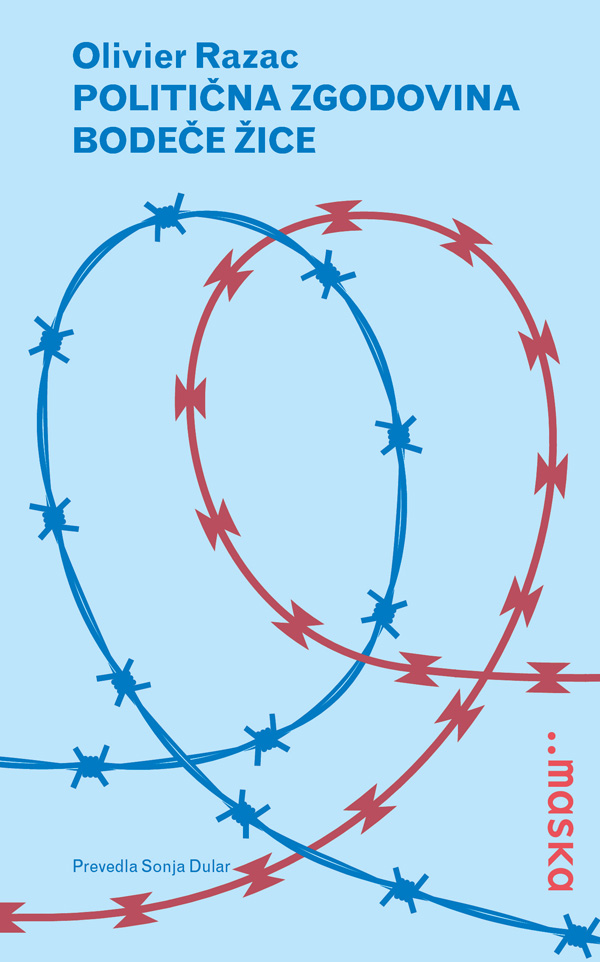Oliver Razac: Barbed Wire, A political history

In contemporary history, the author marks three moments as paradigmatic for the barbed wire as a means of political management of space: one, the invention of the barbed wire that happens in 1874 int the USA, where it was originally used to mark private prairie territory in the time of conquering the “Wild West” and played a key symbolic role in the ethnocide that the white colonisers committed over the indigenous population. Two: during World War I, where barbed wire was used in positional warfare. Three: the use of barbed wite in the architecture of concentration and extermination camps during Nazism.
The historical overview and its conceptual clarity make Razac’s Barbed Wire, A Political History even more current today than it was when it was published in France: we are living in an era when after “the end of history” – which was marked by erasing borders, international unification, and networking – certain European countries (and Slovenia is among them) again “defend” their sovereignty with a new and technologically improved version of the good old barbed wire.
Mediakcije Collection, book no. 15
Original title: Histoire politique du barbele: La prairie, la tranchee, le camp
Translation: Sonja Dular
Preface: Boštjan Nedoh
12 × 16cm
© Maska, Ljubljana, 2016
ISBN 978-961-6572-44-6
This book was published in Slovenian.
Excerpt
“Bodeča žica ima v zgodovini tehnologij za razmejevanje prostora čisto poseben položaj. Na prvi pogled je zgolj poljedelski instrument, se pravi, samo orodje za uresničevanje pradavne funkcije: ograjevanja polja. Toda njena odločilna vpletenost v treh največjih modernih katastrofah naznanja, da je tudi privilegirani objekt za prostorski vpis oblastnih razmerij, značilen za moderni čas. Prvič, bodeča žica izhaja iz edinstvene radikalizacije prostorskih razmejitev. Izključiti, to odslej implicira potek meje med življenjem in smrtjo. Drugič, bodeča žica naznanja, da moderne razmejitve niso namenjene toliko političnim subjektom kolikor elementom populacije, s katero upravlja biopolitika. Vključeni niso nič manj animalizirani od izključenih. Tretjič, bodeča žica pojasnjuje vez med funkcionalno učinkovitostjo modernih »heterotopij« in hierarhiziranjem prostora.”
Olivier Razac, Barbed Wire, A Political History
Contents
PRERIJA, STRELSKI JAREK, TABORIŠČE
AMERIKA: OGRAJEVANJE PRERIJE
Iznajdba bodeče žice in osvajanje zahoda
Meja napreduje, Indijanci se umikajo
Kavboj in bodeča žica
PRVA SVETOVNA VOJNA: STRELSKI JARKI
Moderna vojna, strelski jarki in postranske zaščite
Bodeča žica in velika vojna
Korenjaki in bodeče žice
TABORIŠČE
Taborišče so bodeče žice
Znotraj bodečih žic: organizirano opustošenje
Bodeča žica, simbol skrajnega ujetništva
DRUGI DEL
Bodeča žica in politično upravljanje s prostorom
Meja med življenjem in smrtjo
Varovanje črede in pokončanje zveri
Hierarhiziranje življenja
Virtualizacija prostorskih razmejitev
TRETJI DEL
Nove prostorske razmejitve
Vseprisotnost bodeče žice
Cena simbola: Za politično geografijo bodeče žice
Nove razmejitvene tehnologijae: izključevanje, hierarhiziranje in dajanje v obtok
EPILOG
Geolokalizacija: Od kuge do črnih koz?
Boštjan Nedoh
Rezilna žica: Novo poglavje v politični zgodovini bodeče žice
Spremna beseda
Book presentation
About author

Olivier Razac is a philosopher. Since 2014, he has been lecturing at the Grenoble Alpes University, France. In his work, he focuses on the exercise of power in contemporary societies, continuing in the analysis of Michel Foucault. In his books, he writes on the development of the technology of power from the barbed wire to the electronic bracelet (Histoire politique du barbelé, 2000, 2009; Slovenian translation: Politična zgodovina bodeče žice, 2016), and on the rationalities through which institutions manage people, especially in the field of media (L’écran et le zoo, 2002; Slovenian translation: Ekran in živalski vrt, 2007), health (La grande santé, 2006), and criminal law. Currently, he is studying the forms of legitimizing political authority from a distinctly anti-authoritarian perspective.
Reception in public
Izak Košir: Bodeča žica in njena politična zgodovina
Mladina / 24. 11. 2016
The historical overview and its conceptual clarity make Razac’s Barbed Wire, A Political History even more current today than it was when it was published in France: we are living in an era when after “the end of history” – which was marked by erasing borders, international unification, and networking – certain European countries (and Slovenia is among them) again “defend” their sovereignty with a new and technologically improved version of the good old barbed wire. In his book, Razac emphasizes that we must lean on the historical and conceptual analysis to understand an explain its political role.
Francoski filozof Oliver Razac o bodeči žici
TV Slovenija / Kultura / 25. 11. 2016
“Regular barbed wire can be used in fields to fence in the bovine animals. Not horses, it’s not used for the horses as it’s too dangerous and can injure them, but they use it for cows. Razor wire, on the other hand, is only used for people, as it is far too dangerous for animal fences.”
Lenart J. Kučič: Vrnitev zgodovinskih simbolov brutalnega nasilja
Delo / Sobotna priloga / 2. 12. 2016
For Razac, the barbed technological innovation is equally important as the invention of the 15-round Winchester gun or the later Gatling gun with which the white colonialists supressed numerous revolts in Asia and Africa.